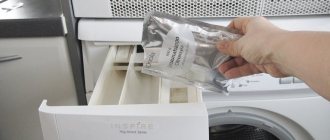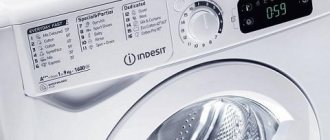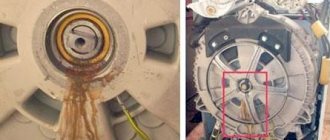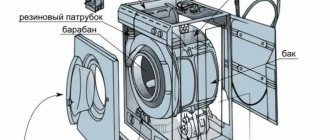The first washing machine: history of appearance
The first device for washing clothes is a board with a ribbed surface.
This type of washing made it possible to get rid of even very difficult old stains. These devices have been used for a long time, simplifying human work. The first device for washing clothes was introduced in 1797 by Nathaniel Briggs. At that time, these “household appliances” had a design in the form of a wooden box with a frame. The frame was set in motion through physical effort. Already in the 18th century, it was possible to make the process of washing things a little easier and faster. Since the introduction of the first washing machine of this type, innovation and improvement have continued.
Over time, washing barrels were created. A crosspiece, powered by a steam engine, rotated inside this structure. Thanks to this, housewives could successfully deal with dirty stains.
Many countries have tried to mechanize this type of washing machine. It was only at the end of the 19th century that the first successes were achieved. The history of the creation of this type of technology is amazing in that the operating principle of the devices has not changed for many years.
Prototype of a washing machine with a drum
In 1851, a washing machine was created, which became the prototype of future washing devices. This washer model was created by James King. The American inventor made a washing device that included a tank with a rotation function in its design. The device worked by hand-pulling and made washing easier for housewives.
The washing machine was made in the form of a cylindrical tub and a tank with holes. The drum was mounted on a central shaft and rotated during washing.
The operating principle of this device was as follows:
- clothes were placed inside this structure;
- then a liquid detergent was added;
- The washing itself was started by a mechanical drive, which had to be rotated manually.
But the unit was very large and required significant physical effort. This device became the predecessor of the future washing machine with a drum.
In 1861, rollers were created for these devices, which dried clothes, which also simplified the washing process. The dryer was attached to the body of the device. Subsequent improvements continued, and prototypes of washing machines were created in many countries, but many of the engineering designs were not viable.
After 15 years, the number of patent applications was more than 2 thousand.
Serial production
The history of the development of this technique began with William Blackstone. This happened in 1874. An American inventor made a device that also worked using manual physical force. He created the washing machine as a holiday gift for his wife. After some time, Blackstone launched this device into assembly line production, selling one unit of equipment for $2.5. The plant he founded is still in operation today.
In 1900, the German company Miele & Cie began producing equipment that became a full-fledged washing machine. The design was based on an improved churn. The appearance of this device was made possible thanks to Carl Millet. These washing machines were very popular among Europeans. At that time, many other companies were also creating washing machines. Moreover, the peculiarity of the new models was that designers and constructors worked on the projects at the same time.
Thus, industrial enterprises managed to develop small-sized equipment, this provided more convenient operation of the machines for consumers. The requirements for physical effort have also decreased.
Who created the washing machine?
The first washing machine was patented by Canadian Noah Cushing in 1824, but did not find public recognition. The fact is that inside the washing tank, blades were attached to the axle, which did not turn over, but simply tore the clothes. American inventor James King took into account the shortcomings and patented a washing machine with a perforated drum in 1851. The unit was manually driven and resembled more a barrel organ than a washing device. The disadvantage of the invention was the small load volume, and it was irrational to spend a lot of effort and time to wash only one shirt.
At the same time, a gold miner from California opened the first laundry, which was a great success. The invention could hold up to 15 shirts at a time, it was driven by at least a dozen mules, and payment was accepted in gold dust.
In 1856, a machine operated by a lever appeared. She imitated hand movements using wooden balls and a frame. Such balls are still used to wash down jackets and blankets, although wood has given way to modern plastic.
American entrepreneurs quickly assessed the market prospects, and by 1857 the patent office had registered more than 2,000 inventions. And in 1861, squeezing rollers saw the light of day; it was these that the Soviet housewife would use until the 1980s.
The model invented by William Blackstone for his wife in 1874 went into mass production. The price of the new product was $2.5, and his company is still operating.
At this time, the German manufacturer of churns and separators Karl Miele found a new use for his inventions: exactly one year after the company was founded in 1900, he produced a washing machine with rotating blades and spin rollers.
The first electric car
The invention of the electric washing machine occurred 8 years later. This made the task much easier for housewives. In 1908, manufacturing companies were already using an electric drive at the base of the washing machine. Since that time, a new stage of improvement has taken place. This washing machine was created by the American Alva Fisher.
The first washing machine was called Thor. I started making washing machines. The device looked like a structure with a rotating tank. There was a tree at the base.
Every year, the number of manufacturers in the USA and around the world has increased significantly:
- over several decades the number of manufacturers grew to 1,500;
- the devices were manufactured with both a gasoline engine and an electric motor;
- Many companies were engaged in the manufacture of washing machines, but only Whirlpool managed to conquer the main market for this equipment.
This enterprise revolutionized stylistic design. After certain developments by engineers, Whirlpool washing machines began to be covered with plastic panels. Very quickly, other factories began to follow this example and improved the devices. The first semi-automatic washing machines began to appear.
Automatic washing machines
The market at the end of 1950 could only offer semi-automatic models, especially in the USA and European countries. However, a year later the situation changed dramatically, since at that time the first machine gun appeared. The design of the device was similar to modern models, as it was equipped with a spinning mechanism.
The machine was equipped with two toggle switches - one to start washing, the second to dry. Although modes had to be switched manually, this was another step forward.
Already in 1962, the Miele corporation developed the first automatic machine, to control which you only had to press one switch. The main disadvantage of the models of that time was that the spin was rather weak, since the drum rotated at a maximum speed of 600 rpm.
Although in 1970 a device was introduced with a speed of 1000 revolutions. The washing machine was very noisy, however, it performed its functions at the proper level.
Already in 1978, the same Mila proposed a project for a real machine that received microprocessor control. Then the engineers presented a finished model, in which it was no longer necessary to switch modes. The product became a real prototype of modern solutions and was able to carry out a full washing cycle.
Further, manufacturers began to improve their designs, gradually adding new features, including:
Creating an automatic washing machine
In 1948, the first software device was developed for washing machines. For autonomous operation of the device, the necessary washing functions were printed on perforated cards. This is how an automatic washing machine was created in America. A year later, a centrifugation mode is installed in the design, and now the machine begins to spin out the laundry.
Models are being developed with different options for loading things into the drum: vertical and frontal. Clothes are washed, wrung out, and dried. After 2 years, the production of this equipment is put into industrial production in Europe.
In 1978, the first washing machine appeared, which had a special control program in its design. The washing machine was operated using a microboard. In the early 80s, automatic cars were manufactured almost all over the world.
In the 90s, washing devices with different technologies were developed. Washing machines now operate on the principle of “smart” technology. Every year, manufacturers improve their products, this allows them to solve many different problems.
Today, various technologies are available to consumers; in short, among the most popular are:
- Aqua Stop.
- Power Stick.
- Add Wash.
- Eco Bubble.
Vertical and front loading of laundry
Front washing machines are more popular in European countries. And in some parts of Europe, for example, in France, vertical machines are more common.
In front-facing vehicles, loading occurs through a transparent hatch, which is located on the front side. Through it you can monitor the progress of the wash. When positioning the machine, it is necessary to take into account that its door opens forward. To use it comfortably, you need to leave free space in front of the machine hatch. You can use the upper part of the machine as a table (only if there is no vibration during operation). If the model of the machine and its location allows, then you can install a sink above it.
On top-loading machines, laundry is placed into the tub through an opening top lid. Therefore, you do not need to worry about free space in front of the machine. But it will be difficult for you to use it as a table. Since the top cover plays the role of a hatch for loading laundry, it must open freely.
Interesting:
- Secrets of cleaning the washing machine drum
- Can I wash with liquid laundry soap?
- What types of dishwashers are there? Types and types
- How to clean your dishwasher from grease...
- Best dishwasher detergent - rating
- Washing with laundry soap in a washing machine
Reader comments
- Share your opinion - leave a comment
The first washing machine in the USSR
The history of the Soviet washing machine with vertical loading of laundry began in 1950. This year, activator washing machines “EAYA-2” and “EAYA-3”, which were assembled at a plant in Riga, began to appear on store shelves in the USSR.
The appearance, like the rest of Soviet equipment, was practically not similar to foreign models - these washing machines were similar to a rocket.
Washing machine "Vyatka"
In 1966, activator washing machines “Vyatka” appeared in the Soviet Union, the design of which was a barrel with an electric motor. In all the time since the production of the first EAYA washing machines, the progress of Soviet engineers has only reached the installation of a timer.
Semi-automatic machines with centrifuge
In the following years, almost nothing changed - the domestic industry actively produced “barrels with motors,” highlighting the high reliability of such washing machines, defining this indicator as the main advantage.
A little later, the first semi-automatic machines equipped with centrifuges began to appear in the Soviet Union. The main example is the Siberia machine, which could squeeze things out. Subsequently, many similar models were created that are still manufactured today.
The first Soviet automatic washing machines
At the end of the 60s, the first automatic washing machines appeared in the USSR (the lag behind Western countries was more than 25 years). The prototype of modern washing machines is the Eureka machine. But it can hardly be called automatic - water had to be poured manually. In this case, the washed items were spun in the same tank where hand washing was done.
In the late 70s, Vyatka-automatic washing machines began to be produced in the Soviet Union. They were assembled under license from the Italian enterprise Merloni Eletrodomestechi. It was the first full-fledged automatic washing machine, which had several washing modes. Most likely, the “Vyatka” is the only machine that is not in short supply, since it was manufactured during the times of “stagnation”, and the price of the washer was about 400 rubles, which was very expensive by the standards of that time.
Another washing machine in the Soviet Union was the Volga-10, but it was inferior in technical indicators to the Vyatka, so it was discontinued. The main disadvantage was the significant energy consumption. Although in order to purchase “Vyatka” it was necessary to show a certificate in the store that the apartment has wiring that can withstand significant loads. The first washing machines were the most “gluttonous” equipment in the Soviet Union.
The first washing machine model in the world
Who actually designed the washing machine and at what time is not known for certain. Most likely, the name of its author will remain a secret, since there is practically no information about it.
In ancient times, powerful civilizations had already ceased to exist and few details remained about their everyday life. So, they washed using a special hand-held board.
Today, only facts from the new history of washing machines have been preserved. So, in 1797 in New Hampshire, Nathaniel Briggs constructed a tub from wood, in which the frame rotated clockwise using a special handle. To set such a mechanism in motion, it was necessary to invest a lot of effort, so the invention remained unnoticed.
Modern production of washing machines
Today, the production of washing machines has been established and is developing intensively. A large number of companies specialize in the assembly and manufacture of washing machines, the most popular of which are:
- Gorenje;
- Bosch;
- Zanussi;
- Samsung;
- Electrolux.
Regardless of where the washing machine is made, this technique significantly saves time and effort. Technical improvements occur simultaneously with design improvements.
From large-sized units, washing machines have gradually turned into elegant devices that perform necessary tasks, making the washing process easier for housewives.











